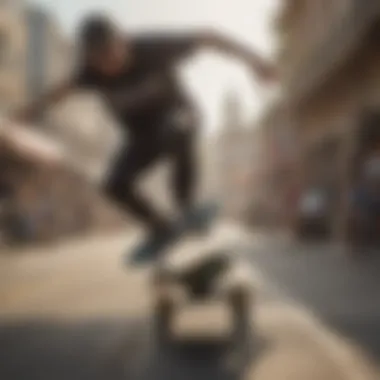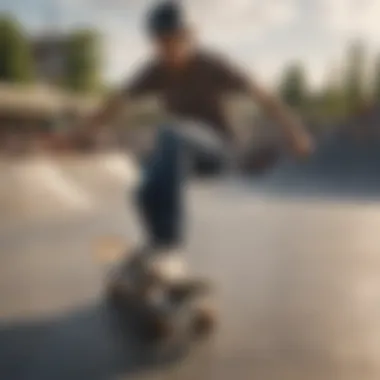The Evolution and Impact of Skateboarding Culture


Intro
Skateboarding occupies a unique position in the realm of extreme sports, blending athletic prowess with artistic expression. Its journey from a rudimentary activity in the post-war era to a multi-faceted global phenomenon showcases not only its evolution but also its broad cultural impact. This article embarks on a detailed exploration of skateboarding, shedding light on various aspects including its history, equipment, community, and the influence of technology in refining both the sport and its participants' experiences.
The significance of skateboarding transcends mere physical activity. It has evolved into a lifestyle, a means of creative expression, and a community builder. As we examine the intricate relationship between skateboarding and its surrounding culture, we aim to illuminate how this activity has shaped identities and created connections across diverse demographics.
Extreme Sports Overview
Definition of Extreme Sports
Extreme sports are typically characterized by their inherent risk and adrenaline-inducing elements. These activities often involve speed, height, and a significant level of physical skill, pushing the limits of human ability. Skateboarding, as one of the core extreme sports, exemplifies this definition, encompassing various disciplines such as street, vert, and slalom.
History and Evolution
The origins of skateboarding can be traced back to the late 1940s and early 1950s in California. Surfers sought a way to practice their skills on land when waves were not present. Initially, boards were simply wooden planks with roller skate wheels attached. Over the decades, skateboarding transformed, with significant technological advancements and the diversification of styles.
The 1970s marked a pivotal time for skateboarding with the introduction of skate parks and professional competitions. This era blossomed into the 1980s and 1990s when influential skateboarders like Tony Hawk and Rodney Mullen drove the culture further, leading to the creation of important tricks and increased visibility for the sport.
Popular Extreme Sports Disciplines
Skateboarding encompasses various disciplines that cater to different skill sets and preferences. Among these are:
- Street Skateboarding: Focuses on performing tricks on urban structures such as stairs, rails, and ledges.
- Vert Skateboarding: Takes place on half-pipes or full pipes, with an emphasis on aerial tricks and flips.
- Freestyle Skateboarding: Involves artistic expression, where riders perform tricks on flat ground.
- Downhill Skateboarding: Focused on speed, involves riding down steep hills or slopes.
Each discipline has its unique culture and techniques, contributing to the broad scope of skateboarding as an extreme sport.
"Skateboarding is not just a sport; it is a community, a culture, and a form of art."
In the next sections, we will delve into the gear and equipment used in skateboarding, the training required to excel, and the best locations for enthusiasts to enjoy this invigorating sport.
Prelude to Skateboarding
Skateboarding occupies a unique position in the sphere of sports and culture, evolving from its grassroots beginnings into a global phenomenon. This section sets the stage for understanding skateboarding's multifaceted nature, including its historical roots, technological advancements, and societal implications.
Skateboarding is not just a mode of transportation or a sport; it embodies a lifestyle that promotes creativity, community, and self-expression. It has become an art form, a means for individuals to showcase their skills while navigating urban landscapes. This article aims to unpack the evolution and impact of skateboarding, providing insight into its significance in contemporary society.
Understanding the Basics
To appreciate skateboarding fully, one must grasp its fundamental elements. Skateboarding involves riding on a board with wheels, using various techniques to perform tricks or navigate obstacles. The basic components of a skateboard include the deck, trucks, and wheels. Each of these parts plays a crucial role in the overall functionality of the board.
The deck serves as the platform where the rider stands. It is often made from layers of plywood, providing strength and flexibility. Trucks are the metal parts mounted on the deck, allowing rotation and steering. The wheels, made from urethane, come in different hardness levels, affecting the ride quality and grip on various surfaces.
The basic techniques in skateboarding range from simple riding to more complex tricks like ollies and kickflips. Understanding these basics is essential for both beginners and seasoned riders. For newcomers, learning these core skills provides a foundation for more advanced maneuvers.
The Significance of Welcome Boards
Welcome Boards are often referred to in the skateboarding community as the boards that provide a sense of inclusion for newcomers. These boards are characterized by user-friendly designs, making it easier for beginners to learn and enjoy the sport. They often come with wider decks and softer wheels, which promote stability and control.
The importance of such boards cannot be overstated. They serve as the entry point into the skateboarding community, encouraging participation and fostering a positive environment. A welcoming design allows new riders to build confidence, helping them transition from novice to proficient riders.
In addition, Welcome Boards play a crucial role in community building. Skate parks and urban spaces equipped with these boards become hubs for social interaction. They attract a diverse group of individuals, creating a supportive network that encourages skill sharing, mentorship, and camaraderie among skaters.
"Skateboarding is a bridge that connects individuals, transcending age, nationality, and social backgrounds."
This introduction into the essentials of skateboarding sets the groundwork for further exploration of its history, mechanics, cultural significance, and safety considerations later in this article.
Historical Perspective of Skateboarding
The history of skateboarding is more than a chronological timeline of events; it serves as a lens through which we can understand the growth of a sport that has transcended its origins to become a global cultural phenomenon. This section will explore the roots of skateboarding, starting from its inception to its current status, revealing how each phase has contributed to its evolution. Understanding the historical trajectory is essential because it provides context for the current practices, styles, and communities that define skateboarding today.
Origins in California
Skateboarding emerged in the late 1940s and early 1950s on the sun-soaked streets of California. It began as a creative outlet for surfers looking to replicate the fluidity of their sport on land. The first skateboards were homemade, consisting of wooden planks with roller skate wheels attached. These rudimentary designs allowed early skaters to perform basic tricks and maneuvers, paving the way for future innovations.
The 1960s saw a greater commercial interest in skateboarding. Companies like Makaha and Hobie began producing ready-made skateboards, introducing standardized equipment that increased accessibility. This era also marked the rise of skateboarding competitions, reflective of its emerging popularity. The California lifestyle, characterized by freedom and self-expression, was encapsulated in the spirit of skateboarding, making it appealing to youth culture.
The Evolution Through the Decades
As the years progressed, skateboarding underwent significant changes, shaped by technological advancements and cultural shifts.
- 1970s: The invention of the urethane wheel revolutionized the sport, allowing for better grip and speed. Skate parks began to appear, providing dedicated spaces for skaters to hone their skills. This period gave birth to legendary skaters like Tony Hawk, whose influence is still felt today.
- 1980s: A surge in creativity marked this decade. The introduction of skateboarding tricks that combined elements from surfing and BMX pushed the limits of what was possible. Magazines and videos became key in documenting the sport, fostering a community that shared both styles and techniques.
- 1990s: The focus shifted back to street skating, emphasizing urban environments as skate venues. The rise of professional skateboarders created a new industry, complete with sponsorships and endorsement deals. Skateboarding began entering mainstream culture, further embedding it into the fabric of youth identity.
- 2000s and Beyond: Skateboarding continues to evolve, with the introduction of digital media reshaping how skaters share their experiences and skills. Social media platforms have enabled a global community where ideas and styles circulate freely.
"The essence of skateboarding lies not just in the tricks, but also in the freedom and creativity it inspires in its practitioners."


The historical perspective of skateboarding offers valuable insights into its current state, illustrating how each decade contributed to the sport's identity. In understanding this evolution, we can better appreciate the depth and complexity of skateboarding today, marking its profound impact on global culture.
The Mechanics of Skateboarding
The mechanics of skateboarding are foundational to understanding the sport. This segment focuses on the critical elements that contribute to the performance, safety, and enjoyment of skateboarding. By breaking down the components that make up a skateboard and discussing technological innovations, we can appreciate how these aspects enhance the experience for riders of all skill levels.
Components of a Skateboard
Deck Design
Deck design is crucial in defining a skateboard's functionality and usability. The shape, size, and material of the deck contribute significantly to overall performance. One key characteristic of deck design is its concave shape, which provides increased control and stability during tricks.
A popular choice among riders is the wider deck, which offers greater footing while performing tricks or cruising. This unique feature allows for better balance and confidence as the rider maneuvers. However, a wider deck might feel bulkier to some riders, impacting their agility during quick moves.
Truck Systems
Truck systems are equally essential as they connect the wheels to the deck. The main function of the trucks is to enable turning and provide stability. One notable characteristic is the height of the trucks. High trucks allow for greater wheel clearance, making them a beneficial choice for riding ramps and performing tricks.
A unique feature of truck systems is the bushings, which can be adjusted for sensitivity. This gives riders control over how their skateboard reacts while turning. While softer bushings provide a smooth ride, they can also reduce stability at high speeds, presenting a consideration for those choosing their setup.
Wheels and Bearings
The wheels and bearings are often regarded as the final component that completes a skateboard. The size and hardness of wheels can affect how a skateboard rides on different surfaces. For instance, larger wheels are beneficial for rough terrain as they roll smoothly over obstacles.
The characteristic here is the durometer rating, which indicates the hardness of the wheels. Softer wheels generally provide more grip, making them suitable for street and park skating. Conversely, harder wheels slide better on smooth surfaces but may offer less traction.
Bearings, which sit inside the wheels, play a role in reducing friction and allowing the wheels to spin freely. Quality bearings can significantly enhance the skateboard's performance. However, they require regular maintenance, which can be seen as an inconvenient aspect for some riders.
Tech Innovations in Skateboards
Electric Skateboards
Electric skateboards represent a significant advancement in skating technology. The key characteristic of these boards is the motor that allows for powered movement. This technology enables riders to maintain higher speeds with less effort, appealing especially to those commuting or seeking longer rides.
A unique feature of electric skateboards is the regenerative braking system, which helps prolong battery life by converting kinetic energy back to battery power during braking. However, while they offer convenience and added speed, electric skateboards can be heavier and more costly than traditional boards.
Material Advancements
Material advancements in skateboard production have also transformed the sport. Innovations like maple wood, bamboo, and even carbon fiber offer various benefits. One major advantage of newer materials is their improved durability and flexibility, which enhances performance.
A notable feature of materials like carbon fiber is their lightweight nature, making the skateboard easier to handle and more responsive. However, the cost of these materials can be a barrier for entry-level skaters, which raises considerations about accessibility within the sport.
The mechanics involve understanding not just the components, but how they interact to create a holistic skateboarding experience.
By exploring both the components of a skateboard and the technological innovations, it is clear how these mechanics shape the riding experience. Enthusiasts and beginners alike can benefit from knowing these aspects to select the right setup and enhance their skills.
The Skateboarding Community
The skateboarding community plays a pivotal role in the sport's growth and cultural significance. It encompasses not just those who ride skateboards, but also enthusiasts, organizers, and supporters of skate culture. The bonds formed within this community contribute to the collective identity of skaters worldwide. Through shared experiences, participants cultivate a sense of belonging, making skateboarding more than just a pastime or sport.
Skate parks and urban spaces are essential for providing environments where skaters can practice and develop their skills. These spaces foster creativity and innovation, often serving as venues for social interaction and inclusion. With access to skate parks, individuals from diverse backgrounds may come together, breaking down social barriers through their mutual love for skateboarding.
Events and competitions serve as another vital aspect that solidifies community ties. They not only showcase talent but also enhance camaraderie among skaters, celebrating their achievements and passions. Participation in these activities elevates the communal experience, making individuals feel recognized and valued in a larger context.
Overall, the skateboarding community enriches the culture surrounding the sport. It provides a network of support, friendship, and challenge that shapes individual journeys and collective progression.
Skate Parks and Urban Spaces
Skate parks and urban spaces are distinguished by their design and purpose, catering specifically to the needs of skateboarders. These areas are equipped with ramps, rails, and various terrains that allow for different styles of skating. The development of skate parks has broadened access to skateboarding and cultivated a new generation of skaters.
Establishing skate parks in urban spaces can significantly enhance local youth engagement. They offer safe environments for practicing, thereby reducing the likelihood of accidents in public roads. Furthermore, skate parks can boost local economies, drawing visitors and encouraging related businesses such as skate shops and cafes to thrive. Their design often involves input from the skate community, ensuring that these spaces meet the needs of local skaters effectively.
Events and Competitions
Events and competitions are integral for both individual recognition and community development. They provide platforms where skaters can demonstrate their skills while fostering friendly competition. By participating, skaters often feel motivated to improve and innovate their techniques.
Local Contests
Local contests often hold significant value within the skateboarding community. These events typically encourage participation from skaters of all skill levels, making the competitions accessible to beginners as well as seasoned riders. The intimate setting of local contests allows for personalized experiences and builds community bonds. Skaters often support each other, cheering and providing encouragement, creating an atmosphere of positivity.
A key characteristic of local contests is their ability to discover new talent. Often, they serve as stepping stones for skaters to showcase their abilities and potentially gain recognition. However, the competitive nature of these events can also induce pressure on participants.
The unique feature of local contests is their informal ambiance. This slightly less formal atmosphere alleviates some stress associated with high-stakes competitions, enhancing enjoyment and fostering friendships. However, the less rigorously structured format may lead to inconsistencies in how events are marketed and organized.


International Championships
International championships play a crucial role in elevating the skateboarding discipline on a global scale. These large-scale events showcase the top talents from around the world, providing a platform for exceptional skills and creativity. The competitive edge at these championships drives innovation in skateboarding techniques, pushing the sport’s boundaries.
A key characteristic of international championships is their extensive media coverage. Increased visibility offers skaters a broader audience, which can lead to sponsorship and professional opportunities. This exposure elevates the sport, attracting more enthusiasts and inspiring the next generation of skaters.
A unique feature of international championships is the level of professional organization. These events are meticulously planned, ensuring fairness and high standards in judging. However, the heightened competition can come with significant pressure for participants, impacting their performance and enjoyment.
Overall, each aspect of the skateboarding community, from the local contests to international championships, interconnects to create a rich culture that supports development, bonding, and expression among diverse groups.
Cultural Impact of Skateboarding
Skateboarding is not just a sport; it represents a culture. The influence of skateboarding expands beyond the physical act of boarding. It embodies a specific attitude, lifestyle, and art form. This impact can be seen in aspects such as music, film, fashion, and social dynamics. Understanding these layers reveals how skateboarding has evolved into a cultural phenomenon, affecting generations across the globe.
Skateboarding in Music and Film
Music and film have played significant roles in shaping skateboarding culture. Many bands and genres have embraced skateboarding, integrating its ethos into their identity. Punk rock, for instance, has long been associated with the skate community. Bands like The Misfits and Black Flag helped fuel an underground scene tied closely to skateboarding. Their raw sounds and anti-establishment lyrics resonate with the rebellious nature of skaters.
Films such as Dogtown and Z-Boys and the Tony Hawk's Pro Skater video game series have further popularized the extreme sport. These films capture the history and spirit of skateboarding while reaching wider audiences. They showcase the lives of prominent figures and the passion behind the wheels. Skaters often find representation in films, leading to a greater understanding of their subculture.
The film industry continues to spotlight skateboarding in various forms. Independent films often explore themes related to identity, struggle, and passion. These narratives foster empathy and engagement with non-skaters, often bridging gaps between different communities.
Fashion and Lifestyle Choices
Skateboarding has a distinct fashion sense that reflects its culture. Skate brands like Supreme, Thrasher, and Vans provide clothing and footwear designed specifically for skaters, ensuring style and functionality. The aesthetic is often casual, characterized by baggy pants, graphic tees, and iconic sneakers.
Over the years, skateboarding has shaped lifestyle choices and influenced mainstream fashion. Styles from the skate world often bleed into streetwear and high fashion. Many designers have incorporated elements from skate culture into their collections, showcasing the versatility and appeal of this unique aesthetic. This blend has led to collaborations that merge skateboarding with lifestyle trends, making it accessible to a broader audience.
Skateboarding also encourages a certain mindset. It promotes personal expression, creativity, and resilience. As skaters navigate through obstacles, both on and off the board, they often embody values such as determination and community. These principles resonate with countless individuals, influencing their lifestyle choices in profound ways.
"Skateboarding isn't just about tricks; it's about lifestyle, community, and self-expression."
Skateboarding as a Form of Expression
Skateboarding is not merely a sport; it represents a unique form of expression for many individuals. This section explores how skateboarding transcends physical movement, evolving into a medium through which enthusiasts communicate their emotions, beliefs, and identities. For many skaters, the act of skating is about more than tricks and techniques; it is an art form that showcases creativity and personal narrative.
Artistic Elements in Skateboarding
Art in skateboarding manifests in various ways. Many skaters customize their decks with graphics that resonate with their personal tastes. The design choices made during skateboarding, including aesthetics and visual flair, can significantly impact a skater's identity.
Skaters often view the movements and tricks they perform as an extension of their artistic expression. The fluidity and style of a trick can mirror dance or performance art. The environment also plays a role in this artistic expression. Each rail, ramp, or ledge presents an opportunity for individual interpretation. This approach transforms public spaces into canvases, allowing skaters to express themselves through their actions.
Key Aspects of Artistic Expression in Skateboarding:
- Deck Design: Skaters commonly choose or create designs that reflect their personality.
- Performance Style: Every skater has a unique way of executing tricks that contributes to their individual style.
- Environment Utilization: Skaters adapt to different locations, using various elements within their surroundings to enhance their artistic expression.
"Skateboarding is a way of life, an expression of who you are." - Anonymous
Personal Style and Identity
The identity of a skater is inherently tied to personal style. Each skater’s choice of gear, from shoes to clothing, helps reflect their beliefs and artistic inclinations. The intersection of fashion and skateboarding is palpable. Brands like Vans and Thrasher have garnered cult-like followings. This relationship between skateboarding and fashion influences how skaters are perceived in broader society.
Additionally, the community aspect plays an essential role in shaping individual skate identities. For many, skateboarding fosters a sense of belonging and camaraderie within diverse groups. This community influences personal expression, encouraging skaters to explore new styles and techniques. In essence, skateboarding becomes a dialogue between the individual and the community, merging personal views with collective experiences.
Important Factors Influencing Personal Style and Identity:
- Fashion Choices: Specific brands often signify affiliation with certain skating cultures.
- Cultural Influences: Music and art often inform the identity of skaters, as many draw inspiration from varied cultural elements.
- Peer Interaction: Skateparks serve as spaces where shared experiences shape individual identity and encourage personal growth.
In summary, skateboarding serves as a crucial outlet for self-expression. The artistic elements, along with personal style and identity, illustrate how the sport goes beyond performance. By examining these aspects, one gains insight into the deeper connection between skaters and their craft.
Safety in Skateboarding
Skateboarding can be an exhilarating activity. However, it also comes with risks. Safety is a crucial aspect for every skateboarder, whether they are beginners or advanced riders. The right protective gear and preventive measures can significantly reduce the risk of injury. Understanding the importance of safety not only enhances the enjoyment of skateboarding but also promotes longevity in this sport.
Protective Gear Importance
Helmets
Helmets play a vital role in skateboarding safety. They help to protect the head from injuries in case of falls or collisions. The key characteristic of helmets is their ability to absorb impact. This makes them a necessary component for all skateboarders. Many riders recognize helmets as a smart choice for safe skating.
The unique feature of helmets is their design that ensures comfort while riding. Modern helmets are lightweight and come with ventilation features, which can prevent overheating. However, there is a downside; some skateboarders may view helmets as uncomfortable or may not like the look. Despite this, the protective benefits outweigh the aesthetic concerns. Riding without a helmet increases the chance of serious injuries.
Protective Pads


Protective pads, including knee and elbow pads, add another layer of protection. These pads are designed to absorb shocks and minimize the impact of falls. The key characteristic of protective pads is their cushioning effect. They are popular among skateboarders for their role in preventing scrapes and bruises.
The unique feature of protective pads is their customization options; they come in various sizes and styles to fit individual preferences. While some may feel restricted by wearing pads, they are significantly advantageous in reducing injuries. Overall, using protective pads is a wise decision, especially for beginners who are more likely to fall.
Injury Prevention Strategies
There are several strategies for preventing injuries while skateboarding. These strategies can promote safer skateboarding experiences. One significant approach is proper technique. Learning how to fall safely can drastically reduce the severity of injuries. Additionally, warming up and stretching before riding can prepare the body for physical exertion.
Other injury prevention strategies include:
- Skate in safe areas. Always choose designated skate parks or appropriate spaces free of obstacles.
- Be aware of surroundings. Constantly checking the environment helps prevent accidents with pedestrians or vehicles.
- Avoid risky tricks. Beginners should focus on simplicity before advancing to complex maneuvers.
- Ride with others. Having partners can help provide assistance and promote safety awareness.
"Preventing injuries is as important as mastering techniques in skateboarding. Safety aids enjoyment and fosters long-term participation in the sport."
By adopting these practices, skateboarders can enjoy the thrill of the sport while minimizing risks.
Environmental Considerations in Skateboarding
Skateboarding has grown to become more than just a recreational activity. It affects communities and the environment, making environmental considerations critical to the sport's future. This section explores how the skateboarding community can contribute positively to environmental sustainability through the adoption of eco-friendly materials and collective actions like clean-up efforts.
Sustainable Materials in Skateboard Production
The production of skateboards involves various materials that can have a significant impact on the environment. Traditional skateboards often utilize wood from trees, plastics, and metals. These materials can contribute to deforestation and pollution, especially when not sourced sustainably.
In recent years, many companies have begun to shift towards sustainable materials. For example, bamboo, a fast-growing grass, has gained popularity due to its resilience and eco-friendliness. Additionally, recycled plastics are being used to create skateboard decks, thereby reducing the need for new raw materials and minimizing waste.
Some skateboard manufacturers are even exploring biodegradable composites that can decompose after their lifecycle, leaving a smaller footprint. This shift not only reduces environmental harms but can also educate consumers on the importance of eco-conscious choices.
Community-led Clean-ups and Initiatives
Skateboarding communities are often at the heart of urban environments, where they can directly impact local ecosystems. Community-led clean-up initiatives are one way skaters are addressing environmental issues. By organizing events to clean up parks, streets, and skate spots, skaters can promote responsibility and encourage a cleaner environment.
Such efforts not only help to remove litter but also foster a sense of unity and community within the skateboarding culture. Participants can experience the satisfaction of improving their local environment while also spreading awareness about the importance of protecting natural spaces.
These initiatives can take various forms, including:
- Regular beach clean-ups at coastline areas where skaters often gather.
- Collaborations with local organizations for trash collection campaigns.
- Awareness programs that educate youth on the environmental impact of pollution.
"The future of skateboarding depends on how we engage with the world around us. It's not just about riding; it's about taking care of our environment too."
By taking part in such activities, skaters exemplify how the sport can align with environmental stewardship. These actions not only highlight the community's commitment to sustainability but also inspire others to consider their role in protecting the planet.
In summary, environmental considerations in skateboarding reflect a significant aspect of the sport's evolution. Through innovative materials and active community engagement, skateboarding can contribute to a more sustainable future.
Future Trends in Skateboarding
Understanding the future trends in skateboarding is vital. It serves as a glimpse into what lies ahead for this dynamic sport. Skateboarding has evolved through numerous phases, and recognizing emerging trends can provide insights about evolving styles, interests, and community dynamics. Keeping abreast of these trends allows enthusiasts and participants to engage more deeply, enhance their experience, and remain relevant in a rapidly changing environment.
Emerging Skateboarding Styles
New styles in skateboarding continue to develop, driven by innovation and the creativity of the community. One prominent trend is the rise of freestyle skateboarding. This style emphasizes tricks on flat surfaces and has seen a resurgence partly due to social media showcasing unique skills. Skaters are now experimenting with more complex, technical tricks that were not traditionally part of this genre.
Another emerging style is known as "cruising," which focuses on smooth, effortless riding that prioritizes enjoyment over technical tricks. More skateboarders are choosing to ride longboards for this purpose, as they offer a comfortable option for those who appreciate a more laid-back approach.
Moreover, the influence of global culture cannot be overlooked. Diverse cultures are bringing their unique expressions into the sport, blending styles, techniques, and approaches. For example, the blend of street culture from urban environments with more traditional skateboarding has fostered new hybrid styles. This evolution encourages inclusivity while pushing artistic expression in skateboarding.
The Role of Social Media
Social media has become an essential component in the skateboarding community. Platforms like Instagram, Facebook, and Reddit have created a space for skaters to connect, share, and inspire one another. These platforms enable skaters to showcase their talents to a broader audience, breaking geographical barriers.
The role of video content is especially significant. Skaters can post videos of their tricks, helping others learn new techniques or styles. This also creates opportunities for sponsorships, where talented individuals may get noticed by brands seeking fresh talent.
Additionally, social media serves as a hub for communities to come together around events or meet-ups. Organizing through these platforms allows skaters to share information about local competitions or skate parks, fostering connection and camaraderie among enthusiasts.
In summary, the future of skateboarding seems promising and vibrant, marked by new styles and the impact of social media. These elements combine to shape a distinct culture that continues to evolve, welcoming everyone to participate and express themselves fully.
Epilogue
The conclusion of this article serves as an essential reflection on the integral role skateboarding plays in contemporary culture, sports, and personal expression. As we have explored throughout the article, skateboarding transcends mere recreational activity; it occupies a significant space within urban landscapes and youth identity. Understanding these dynamics provides insight into why skateboarding continues to evolve and adapt, engaging new generations in meaningful ways.
The Continuing Evolution of Skateboarding
As skateboarding persists in its progression, various factors contribute to its ongoing transformation. New trends emerge influenced by cultural shifts, technological enhancements, and community engagement.
- Emerging Styles: Riders incorporate influences from other extreme sports, often blending techniques to create unique personal styles. This fusion not only broadens the scope of skateboarding but also enriches its community.
- Technological Integration: The incorporation of technology will likely shape future avenues of skateboarding. Innovations such as smart skateboards, integrated sensors, and augmented reality experiences are gaining traction. This could elevate the thrill of riding while maintaining safety.
- Social Media's Role: Platforms like Instagram and TikTok continue to forge connections among skateboarders worldwide. Creators share tricks, styles, and experiences, fostering a global community. Users are motivated not just by purpose but by the culture surrounding skateboarding.
In summary, the future of skateboarding is not isolated; it is interwoven with cultural expressions, technological advancements, and community initiatives. This reflects a sport with roots deeply planted in creativity and innovation. As it evolves, so too does its impact, highlighting the necessity for ongoing recognition of its relevance in the sports and lifestyle domains.
"Skateboarding is not just a sport. It is a lifestyle that embodies freedom, creativity, and a spirit of rebellion."
By appreciating its evolution, we can better understand the significance of skateboarding today and its potential trajectory for the years ahead.







